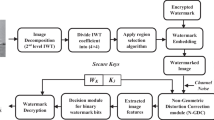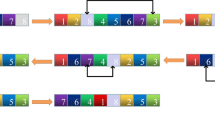Abstract
Robustness of current watermarking schemes of vector maps is mainly dependent on algorithms of watermark embedding and extraction, while few works have been done focusing on error correction algorithms after watermark extraction. In this paper, a reversible watermarking scheme is proposed for vector maps based on error correction codes (ECC). Original copyright information is firstly expressed by a binary array (copyright watermark data), for which ECC are then generated exploiting XOR operation. Then, the copyright watermark data and its corresponding ECC are merged to compose the final watermark data. To enhance the robustness of this scheme under geometric transformation, watermarks are embedded into polar coordinates of map vertices. After watermark extraction, this scheme can not only obtain the original copyright information, but also recover the original map content accurately. Both theoretical analysis and comprehensive experimental results validate the reversibility, invisibility, capacity and robustness of the proposed watermarking scheme.






Similar content being viewed by others
References
Cao LJ, Men CG, Sun JG (2010) Space feature-based reversible watermarking theory for 2D-vector maps. Acta Geodaetica Et Cartographica Sinica 39:422–427
Cao LJ, Men CG, Sun JG (2011) A double zero-watermarking algorithm for 2D vector maps. J Harbin Eng Univ 32:340–344
Cao LJ, Men CG, Ji RR (2013) Nonlinear scrambling-based reversible watermarking for 2D-vector maps. Vis Comput 29:231–237
Cao LJ, Men CG, Gao Y (2013) A recursive embedding algorithm towards lossless 2D vector map watermarking. Digital Signal Process 23:912–918
Cao LJ, Men CG, Ji RR (2014) High-capacity reversible watermarking scheme of 2D-vector Data. SIViP 9:1387–1394
Chen YH, Huang HC, Lin CC (2016) Block-based reversible data hiding with multi-round estimation and difference alteration. Multimed Tools Appl 75:13679–13704
Douglas DH, Peucker TK (1973) Algorithms for the reduction of the number of points required to represent a digitized line or its caricature. Can Cartogr 10:112–122
Huang HC, Chang FC, Fang WC (2011) Reversible data hiding with histogram-based difference expansion for QR code applications. IEEE Trans Consum Electron 57:779–787
Li YC, Yeh CM, Chang CC (2010) Data hiding based on the similarity between neighboring pixels with reversibility. Digital Signal Process 20:1116–1128
Ma YJ, Zhu YS, Liu XY (2016) A novel reversible watermarking scheme for relational databases protection based on histogram shifting. J Inf Hiding Multimed Signal Process 7:266–276
Neyman SN, Pradnyana INP, Sitohang B (2014) A new copyright protection for vector map using FFT-based watermarking. TELKOMNIKA 12:367–378
Peng F, Lei YZ, Long M, Sun XM (2011) A reversible watermarking scheme for two-dimensional CAD engineering graphics based on improved difference expansion. Comput Aided Des 43:1018–1024
Ren N, Wang QS, Zhu CQ (2014) Selective authentication algorithm based on semi-fragile watermarking for vector geographical data. International Conference on Geoinformatics, pp 1–6
Ren WH, Li X, Lu ZM (2017) Reversible data hiding scheme based on fractal image coding. J Inf Hiding Multimed Signal Process 8:544–550
Shao CY, Wang XT, Xu XG, Niu XM (2007) Study on lossless data hiding algorithm for digital vector maps. J Image Graph 12:206–211
Sun JG, Zhang GY, Yao AH, Wu JP (2014) A reversible digital watermarking algorithm for vector maps. Int J Netw Secur 16:40–45
Tashk A, Danyali H, Alavianmehr MA (2013) A modified dual watermarking scheme for digital images with tamper localization/detection and recovery capabilities. International ISC conference on information security and cryptology, pp 60–65
Voigt M, Yang B, Busch C (2004) Reversible watermarking of 2d–vector data. In: Proc. multimedia and security workshop, pp 160–165
Voigt M, Yang B, Busch C (2005) High-capacity reversible watermarking for 2D vector data. In: Proc. SPIE, international society for optical engineering, pp 409–417
Wang NN, Men CG (2013) Reversible fragile watermarking for locating tampered blocks in 2D vector maps. Multimed Tools Appl 67:709–739
Wang XT, Shao CY, Xu XG, Niu XM (2007) Reversible data-hiding scheme for 2-D vector maps based on difference expansion. IEEE Trans Inf Forensics Secur 2:311–320
Wang X, Huang DJ, Zhang ZY (2012) A robust zero-watermarking algorithm for vector digital maps based on statistical characteristics. J Software 7:2349–2356
Weng SW, Pan JS (2014) Reversible watermarking based on eight improved prediction modes. J Inf Hiding Multimed Signal Process 5:527–533
Xiao D, Hu SL, Zheng HY (2015) A high capacity combined reversible watermarking scheme for 2-D CAD engineering graphics. Multimed Tools Appl 74:2109–2126
Yan HW, Zhang LM, Yang WF (2017) A normalization-based watermarking scheme for 2D vector map data. Earth Sci Inf 1–11. 10.1007/s12145-017-0310-x
Yang CS, Zhu CQ (2011) Robust watermarking algorithm for geometrical transform for vector geo-spatial data based on invariant function. Acta Geodaetica Et Cartographica Sinica 40:256–261
Yang CS, Zhu CQ, Tao DX (2010) A blind watermarking algorithm for vector geo-spatial data based on coordinate mapping. J Image Graph 15:684–688
Zhang LJ, Li AB, Lv GN, Lin BX (2008) Study on adaptive watermark of GIS vector data. Geo-Inf Sci 6:724–729
Zheng L, You FC (2009) A fragile digital watermark used to verify the integrity of vector map. International conference on E-business & information system security, pp 1–4
Acknowledgements
This research is supported by the National Natural Science Foundation of China (Grant No. 41171343), and the Special Project for Talents Introduction of Anhui Science and Technology University (Grant No. ZRC2014396).
Author information
Authors and Affiliations
Corresponding author
Rights and permissions
About this article
Cite this article
Qiu, Y., Gu, H. & Sun, J. Reversible watermarking algorithm of vector maps based on ECC. Multimed Tools Appl 77, 23651–23672 (2018). https://doi.org/10.1007/s11042-018-5680-7
Received:
Revised:
Accepted:
Published:
Issue Date:
DOI: https://doi.org/10.1007/s11042-018-5680-7




